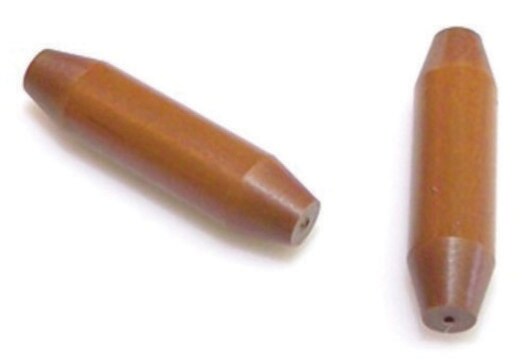23804
Capillary Column Butt Connector
body only (ferrules not included)
Autenticatiper visualizzare i prezzi riservati alla tua organizzazione & contrattuali
About This Item
Codice UNSPSC:
41115700
Prodotti consigliati
Confezionamento
pkg of 1 ea
tecniche
gas chromatography (GC): suitable
Cerchi prodotti simili? Visita Guida al confronto tra prodotti
Categorie correlate
Descrizione generale
Capillary column butt connector is made by inserting two capillaries into a piece of PTFE shrinking tubing, which when heat is applied secures the two capillaries in place. It has shown to have no contribution to band spreading.
This device consists of a double-tapered ferrule and a stainless steel compression body with a threaded nut. Small (2.3 cm x 0.6 cm) and light (4.4 g with ferrule), it provides a gas tight seal without a change in column efficiency or inertness. The columns to be connected can have the same or different internal and external diameters. The butt connection is made inside the special double-tapered ferrule. The ferrule is then compressed within the housing. When the column ends are butted squarely and tightly together, the butt connector will not alter the chromatographic performance of your capillary columns. There is little or no dead volume and little chance of gas flow disruption by following these steps:
- Make sure the bore of the ferrule is clean. Blow out any ferrule fragments with nitrogen. Using a magnifier, examine the column ends to be connected. Make sure each cut is clean and square. The two ends must butt squarely, without any gaps.
- With white typewriter correction fluid, place a reference mark 1/4 inch from the end of the column with the larger bore. This mark will help you to confirm visually that the end of the column is centered within the 1/2 inch ferrule.
- Place the ferrule inside the housing and loosely tighten the nut. Feed the unmarked column completely through the ferrule and out the opposite end. Cut off ~1 inch (25 mm) of the column to ensure no ferrule fragments are in the column. Draw the column back far enough to insert the marked column into the ferrule to the indicating mark. Tighten the nut about 1/8 turn past fingertight.
- Press the ends of the columns together, observing the reference mark to make certain they butt together at the center of the ferrule. Tighten the ferrule to about 1/4-1/2 turn past fingertight. Gently pull on both columns to ensure they are secure. If they are loose, additional tightening is necessary.
Altre note
We offer a variety of chromatography accessories including analytical syringes
Scegli una delle versioni più recenti:
Certificati d'analisi (COA)
Lot/Batch Number
Ci dispiace, ma al momento non ci sono COA disponibili online per questo prodotto.
Se ti serve aiuto, non esitare a contattarci Servizio Clienti
Possiedi già questo prodotto?
I documenti relativi ai prodotti acquistati recentemente sono disponibili nell’Archivio dei documenti.
I clienti hanno visto anche
Packed Bed Column.
Deyl SZ
Capillary Electrophoresis: Theory and Practice, 113-114 (2001)
Il team dei nostri ricercatori vanta grande esperienza in tutte le aree della ricerca quali Life Science, scienza dei materiali, sintesi chimica, cromatografia, discipline analitiche, ecc..
Contatta l'Assistenza Tecnica.






